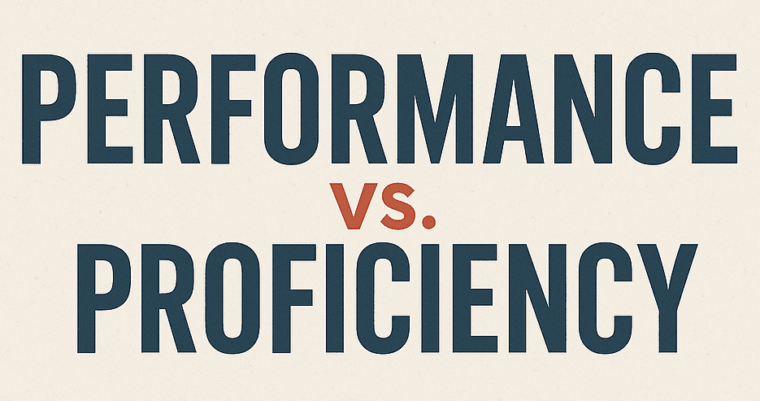Performance vs. Proficiency – What’s the Difference?

Performance vs. Proficiency – What’s the Difference?
In my recent blog post “Language Learning & Language Acquisition – What’s the difference?“, I discussed the difference between the terms “learning” and “acquisition”. Along that same thread, I would like to discuss the terms “performance” and “proficiency” in the context of world language education.
The terms “performance” and “proficiency” are often used interchangeably, but they represent two distinct concepts that are important for educators to understand.
Let’s take a closer look at the differences between “Performance” and “Proficiency”!
Performance:
Performance refers to a learner’s ability to use the language in a specific context and setting, like a classroom. It is influenced by factors such as familiarity with the topic and task, prompts, practice, and exposure to certain vocabulary. In other words, it is using “learned” language skills in a controlled task. It is based on the language curriculum that is taught in class and reflects what a learner can do under controlled or structured conditions, such as:
- Participating in a guided classroom conversation, specific to a topic/unit.
- A writing assignment, specific to a topicunit taught in class
- A memorized or rehearsed speech or role-playing
It is also important to keep in mind that performance can be achieved by practice, feedback, and short-term preparation and doesn’t always indicate long-term language acquisition.
Proficiency:
Proficiency, on the other hand, is more of a broad measure of a learner’s ability to use the language across different contexts and settings, without preparation or structured tasks. That is, it represents a learner’s ability to communicate effectively across a range of unrehearsed, real-world situations. (Think: A range of topics, settings, and circumstances.) It is also typically assessed using scales (ratings), such as the ACTFL Proficiency Guidelines or the CEFR (Common European Framework of Reference for Languages), and is categorized into levels (e.g., Novice, Intermediate, Advanced).
Characteristics of proficiency include:
- Measured independently of specific tasks or memorization (The ability to use the language in unrehearsed situations.)
- Reflects consistent ability across different topics and situations. (Using the language to accomplish real-world tasks without the use of resources.)
- Develops over time through meaningful exposure and use.
Understanding the Distinction
Understanding the difference between “performance” and “proficiency” is important and it is also important to not use them interchangeably. While performance shows immediate skills, proficiency represents long-term language development (acquisition). By focusing on real (purposeful) communication, language learners can move beyond short-term performance and build lasting proficiency. By understanding this distinction, educators can set realistic expectations and guide instruction in the classroom.
I hope this helps clarify the difference between these two terms.
Finally, I’d like to pose a couple of questions for your consideration:
- Can performance lead to proficiency?
- Can both performance and profeciency (peacefully) coexist?
- That is, are they complimentary or mutually exclusive?
- How much does the setting / situation matter when dealing with performance and proficiency?
- Do you have a particular thought / opinion on performance vs. proficiency in the (CI/ADI) classroom?
Please share your thoughts in the comments below!
P.S. Assessing “performance” and “proficiency” is a topic for another time! (But feel free to also leave your comments regarding this topic below!)